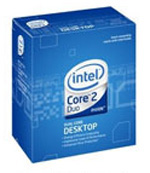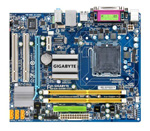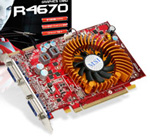Intel Budget
In the past, Intel offerings have tended to be more expensive than configurations from AMD, but our Intel and AMD budget PCs carry virtually identical prices. With prices the same, you can choose your budget system based on other features that are important to you.
| Intel Budget PC | ||
| Hardware | Component | Price |
| Processor | Intel Core 2 Duo E7500 Wolfdale (Dual-core 2.93GHz, 45nm, 65W, 3MB Shared L2, 1066FSB) |
$140 |
| Cooling | CPU Retail HSF | - |
| Video | Sapphire Radeon HD 4770 512MB 100277L | $100 |
| Motherboard | Gigabyte GA-G41M-ES2L Intel G41 Micro ATX | $65 |
| Memory | OCZ Platinum Model OCZ2P10664GK 2x2GB 5-5-5 DDR2-1066 ($63 less $25 Rebate) |
$38 |
| Hard Drive | WD Caviar Green WD6400AACS 640GB 16MB Cache | $65 |
| Optical Drive | Sony Optiarc Model AD-7240S-OB 24X DVDRW SATA | $24 |
| Audio | On-Board | - |
| Case | Cooler Master Elite 330 RC-330-KKN1-GP Mid Tower | $40 |
| Power Supply | BFG Tech LS Series LS-550 550W SLI/CrossFire Ready 80 Plus Certified ($80 less $20 Rebate) |
$60 |
| Base System Total | $532 | |
| Display | ASUS VH222H 21.5" 5ms Widescreen 16:9 LCD (1920x1080) | $155 |
| Speakers | Cyber Acoustics CA3090WB 2.1 Gaming Speakers | $16 |
| Input | Microsoft CA9-00001 PS/2 Keyboard and Optical Mouse | $17 |
| Operating System | Microsoft Vista Home Premium SP1 (for System Builders) | $99 |
| Complete System Bottom Line | $819 | |
 |
The E7500 ups the bus to 1066 from the 800FSB of our entry-level Intel system. A dual-core 2.93GHz with 3MB of cache won't be a slouch in any department in your budget system. Yes the new Core i7 is faster, but it is also much more expensive. The question for a budget system is how good the performance is for the money spent. The E7500 SYSmark 2007 score is about 72% of the top Core i7 965 Extreme. That is fantastic performance for a CPU that costs just $140. The E7500 is also a candidate for overclocking if you are inclined to move the performance a bit closer toward the 3.33GHz Core 2 Duo E8600, which reaches 88% of the i7 965 SYSmark performance. The only drawback to this processor choice is the lack of Intel's Virtualization Technology (Intel VT). If running the Windows Virtual PC under Windows 7 for XP Mode (as one example) is important to you, then moving up to the E8x00 range is the only valid option near this price point.
 |
Unfortunately, we do not have any motherboards in the Intel budget sector that offer the price to performance ratio of our AMD choice. However, we did find a board that would suit most of our needs and it also comes from Gigabyte. The GA-G41M-ES2L motherboard offers a very solid platform for our processor and discrete ATI 4770 video card choices. It could also double as a barebones entry-level contender. This board features the Intel G41 Northbridge and ICH7 Southbridge along with support for 8GB of memory. Gigabyte tosses in the Realtek ALC 888B HD audio codec, Realtek RTL8111DL Gigabit LAN controller, eight USB 2.0 ports, one IDE connector, and four SATA 3Gb/s connectors. The board uses the uATX form factor, and while uATX boards are often a layout nightmare the Gigabyte layout is very good for most applications.
Designed for the casual overclocker in mind, the BIOS allows for decent headroom with FSB speeds hitting 333MHz on our E5200 and E7400 processors. The board has been extremely stable in testing so far and we recommend it. Our only drawback is the small number of SATA ports and the missing support for AHCI/NCQ due to the use of ICH7. In order to get the ICH10 Southbridge, you will have to step up to the G43/P43/P45 offerings that run an additional $15~$30 more for performance-oriented motherboards. That will be a small price for many users, but when every penny counts it can certainly matter.
We did not select an aftermarket CPU heatsink for either budget system to go along with our CPU choices. For this budget, a $50 solution from Thermalright or Scythe is simply not a realistic option, and the stock AMD and Intel heatsinks are good for decent if unspectacular overclocks of the E7500 and Phenom II 720BE. However, if you want spectacular overclocking, both CPUs benefit from better cooling and you can take either CPU to Mt. Olympus heights by adding a better CPU heatsink/fan. You'll just have to decide if the $50 spent on a separate cooler and higher CPU overclocks are better than a larger HDD, faster GPU, better LCD, or more RAM.
 |
Again, we have discussed the option of discrete video cards for our budget systems in past guides. However, it was always an option that would drive up the cost of the system by $150 or so. We just could not recommend an inexpensive budget based card like the ATI HD 4550 as the price to performance benefits over the integrated solutions were just not there. Our opinions changed with the release of the ATI HD 4770 card last month. We did our best to figure out a way to shoe horn in this remarkable "budget" card to create a system that allows midrange gaming performance in most game titles, excellent HTPC capabilities, HD video playback, and crystal clear Aero performance at high resolutions in Windows 7 or Vista. Yes, not everyone in this market sector needs this "luxury" option. We are selecting the ATI Radeon HD 4770 as our jack-of-all-trades GPU for our budget configurations. If you want less performance for a lower cost, the MSI HD 4670 is a reasonable alternative at just $53 after rebate.
The rest of the components are the same as those found in the AMD budget system. Sound cards at this budget are simply an unnecessary luxury, and the onboard offerings continue to improve with each new motherboard generation. You can be reasonably happy with the onboard sound until you figure out if you want to upgrade to something better.










65 Comments
View All Comments
strikeback03 - Thursday, May 14, 2009 - link
So it's pretty much a different keyboard with a touchpad for more money? I suppose they could have recommended a DiNovo mini as well, I'd imagine the input devices used are definitely part of the "personal touch" mentioned for the HTPCs.aftlizard - Thursday, May 14, 2009 - link
59.99 would still keep them under there stated budget and 90 dollars less than the Dinovo keyboard while taking up less space, using less batteries and providing better range than RF.GeorgeH - Thursday, May 14, 2009 - link
"The WD Green is a variable speed energy saving design"Unless I'm very much mistaken, that WD drive does not vary its rotation speed. Their original "5400-7200" RPM claims were purely a marketing thing, a shorthand way of saying "5400RPM power consumption with 7200RPM performance". WD no longer bothers to claim their drives vary in speed, instead merely listing it as "IntelliPower" and nothing more.
Saying it's variable speed is good marketing for people who don't see anything beyond RPM, but as AnandTech isn't on WD's payroll it seems a little out of place here. ;)
Spoelie - Friday, May 15, 2009 - link
What intellipower means is that the caviar green line is engineered to meet a power target, not a (rotational) speed target. They guarantee that the speed is at least 5400rpm tho.If the power budget is 7w, and the current design allows this by spinning the disks at 5800rpm, then that is what you get. The next design revision could bump up the speed to 6100rpm while keeping the same power budget (for example, optically shrunk controller chips, or increased density platters -> less platters needed for the same capacity -- both save power which can be spent increasing rotational speed). That's why you have the caviar green EACS, EADS, ...
coda6 - Thursday, May 14, 2009 - link
I agree, I would love to see an article on Anands HTPC set up, or at least a discussion on the possibilities of the current HTPC tech.goinginstyle - Thursday, May 14, 2009 - link
Back to the HTPC stuff, on page 6, your recommendation is ASUS but the pic is a Gigabyte board from the looks of it.Gary Key - Thursday, May 14, 2009 - link
Fixed.... :)goinginstyle - Thursday, May 14, 2009 - link
I think the .05% of people who will run VT with an entry level system sporting Win7 with XP mode are making much to do about nothing in this case. Yes, VT support is important for certain sectors but this in an entry level guide for the masses, most of whom have no idea what VT support even means and could care less if they did.Anyway, it actually appears some thought went into this guide compared to the previous $800 guide. So good job to the editors who actually did some work instead of mailing in their choices this time.
I would rather see a separate HTPC guide explore choices from the ION up to the i7 and include CableCard, Tuners, NAS, and other components built around a true HTPC.
piesquared - Thursday, May 14, 2009 - link
There is no better choice for an HTPC motherboard than MSI's Maui board on an AMD platform. And DDR2 is still cheaper than DDR3. That would be my recommendaton anyway.Also agree with the above poster regarding Intel's lack of virtualization support.
arklab - Thursday, May 14, 2009 - link
Wow!This time you guys really blew it on the Intel CPU choices, and could be giving novices who might rely on your advice a nasty surprise.
None of the selected Intel CPUs support XT-x - which of course is REQUIRED to run the new virtual XP mode in Windows 7.
Worst of all, you don't even warn the reader of this situation.
The AMD CPUs are all OK, of course.
Please change your recommendations to select "full use" CPUs.